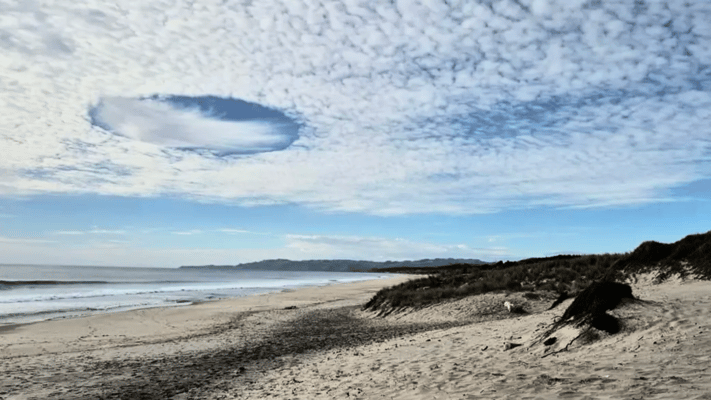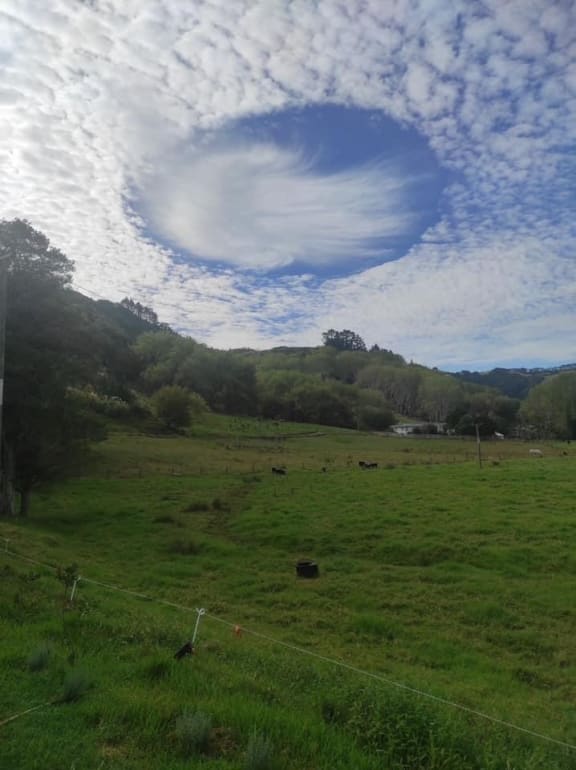Rare 'UFO cloud' has Aucklanders' eyes on the skies

The truth is out there - a "UFO cloud" seen in Auckland's north was not the work of aliens, but a rare meteorological phenomenon.
Residents of Wellsford, Te Hana, Pakiri and the Hibiscus Coast reported seeing the circular cloud formation high in the sky on Thursday morning.
Those who saw it said it looked like a hole in the cloud cover, with some saying a small rainbow was visible inside.
Sheila Russell was at Forestry Beach in Te Arai on Thursday morning taking photos when the cloud appeared.
She said the sky was "already pretty stunning" and the cloud's formation was the cherry on top.
"It literally just appeared in front of me on the empty beach. My initial thought [was] 'wow a UFO cloud'."
Adele Rhead was working at Wellsford Golf Club when a member told her to come outside and take photos.
The member, an older man, told her the cloud was "super rare" and he had only seen two in his lifetime.
It was "super cool" to see, she said.
Lyubov Bykova saw the cloud from Pakiri.
She said she had never seen a formation like that before and would be interested in the scientific explanation.
"[It] looks unnatural, definitely."

The cloud formation is seen from Pakiri. Photo: Supplied/Lyubov Bykova
Meteorologist Ben Noll from the National Institute of Water and Atmospheric Research (NIWA) said while the cloud could be mistaken for a UFO, it was a completely natural phenomenon.
It was known as both a "fall streak hole" and a "punch hole cloud", he said.
Its formation was "pretty rare" and he had only seen one or two in his lifetime.
Some cumulus clouds contained what was known as supercooled water, "which is basically water that is below freezing, but it actually hasn't frozen yet into ice crystals", Noll said.
"Typically what happens is there's some sort of atmospheric disturbance within that supercooled water - it could be an aeroplane or something similar - and that atmospheric disturbance causes that supercooled water to rapidly turn into ice crystals."
Those ice crystals were heavier than the surrounding cloud, so they fell out, leaving a hole behind, Noll said.
The process happened high up in the atmosphere and was fairly quick, he said.
"Once the disturbance comes through, it's probably minutes, maybe tens of minutes."
Noll said the rainbow effect inside the hole was likely another process called cloud iridescence - sunlight interacting with the ice crystals inside the cumulus.
It was a "confluence of unique meteorological phenomena", he said.
The truth is out there - a "UFO cloud" seen in Auckland's north was not the work of aliens, but a rare meteorological phenomenon.
Residents of Wellsford, Te Hana, Pakiri and the Hibiscus Coast reported seeing the circular cloud formation high in the sky on Thursday morning.
Those who saw it said...
The truth is out there - a "UFO cloud" seen in Auckland's north was not the work of aliens, but a rare meteorological phenomenon.
Residents of Wellsford, Te Hana, Pakiri and the Hibiscus Coast reported seeing the circular cloud formation high in the sky on Thursday morning.
Those who saw it said it looked like a hole in the cloud cover, with some saying a small rainbow was visible inside.
Sheila Russell was at Forestry Beach in Te Arai on Thursday morning taking photos when the cloud appeared.
She said the sky was "already pretty stunning" and the cloud's formation was the cherry on top.
"It literally just appeared in front of me on the empty beach. My initial thought [was] 'wow a UFO cloud'."
Adele Rhead was working at Wellsford Golf Club when a member told her to come outside and take photos.
The member, an older man, told her the cloud was "super rare" and he had only seen two in his lifetime.
It was "super cool" to see, she said.
Lyubov Bykova saw the cloud from Pakiri.
She said she had never seen a formation like that before and would be interested in the scientific explanation.
"[It] looks unnatural, definitely."

The cloud formation is seen from Pakiri. Photo: Supplied/Lyubov Bykova
Meteorologist Ben Noll from the National Institute of Water and Atmospheric Research (NIWA) said while the cloud could be mistaken for a UFO, it was a completely natural phenomenon.
It was known as both a "fall streak hole" and a "punch hole cloud", he said.
Its formation was "pretty rare" and he had only seen one or two in his lifetime.
Some cumulus clouds contained what was known as supercooled water, "which is basically water that is below freezing, but it actually hasn't frozen yet into ice crystals", Noll said.
"Typically what happens is there's some sort of atmospheric disturbance within that supercooled water - it could be an aeroplane or something similar - and that atmospheric disturbance causes that supercooled water to rapidly turn into ice crystals."
Those ice crystals were heavier than the surrounding cloud, so they fell out, leaving a hole behind, Noll said.
The process happened high up in the atmosphere and was fairly quick, he said.
"Once the disturbance comes through, it's probably minutes, maybe tens of minutes."
Noll said the rainbow effect inside the hole was likely another process called cloud iridescence - sunlight interacting with the ice crystals inside the cumulus.
It was a "confluence of unique meteorological phenomena", he said.










Leave a Comment